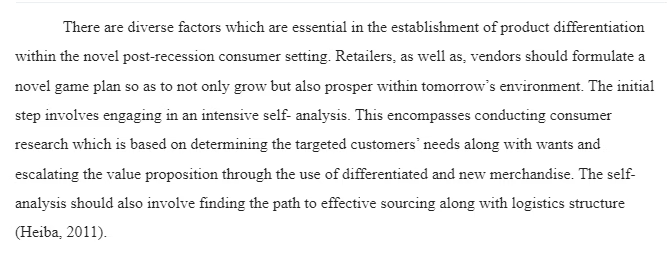Factors and Trends that Influence Strategy Development
In this module, you will explore how businesses react to changing economic times and the influence this has on product and service positioning in the market place. You will also learn about the different approaches an organization may take such as a retrenchment approach, an investment approach, or an ambidextrous approach to provide a foundation for opportunity and risk in recessionary times.
Consumer spending habits have undergone dramatic and enduring change with the slowed economy in the United States.
Using the module readings, Argosy University online library resources, and the Internet, respond to the following:
- What are the factors that are key for establishing product differentiation in the new post-recession consumer environment especially as it relates to economic indicators?
- What is a luxury good and should marketers of luxury goods abandon their efforts to establish premium pricing?
- How do changes in societal attitudes toward companies and products affect the way marketers of consumer goods think about the customer value chain? Provide examples of companies that have changed their approach to marketing in response to a shift in consumers’ value in changing economic times.
Write your initial response in approximately 300 words. Apply APA standards to citation of sources.
Assignment 1 Grading Criteria
Initial response:
- Was insightful, original, accurate, and timely.
- Was substantive and demonstrated advanced understanding of concepts.
- Compiled/synthesized theories and concepts drawn from a variety of sources to support statements and conclusions.
Discussion response and participation:
- Responded to a minimum of two peers in a timely manner.
- Offered points of view supported by research.
- Asked challenging questions that promoted the discussion.
- Drew relationships between one or more points in the discussion.
Writing:
- Wrote in a clear, concise, formal, and organized manner.
- Responses were error free.
- Information from sources, where applicable, was paraphrased appropriately and accurately cited.
Total:
Required Readings
- Efendioglu, A., & Karabulut, A. (2010). Impact of strategic planning on financial performance of companies in Turkey. International Journal of Business and Management, 5(4), 3–12. (ProQuest Document ID: 821297217) http://search.proquest.com.libproxy.edmc.edu/docview/821297217
/abstract?source=fedsrch&accountid=34899 - Heiba, F. (2011). Future global marketing negotiations: A strategic scenario. International Journal of Business and Social Science, 2(4). (ProQuest Document ID: 904523887)http://search.proquest.com.libproxy.edmc.edu/docview/904523887/
abstract?source=fedsrch&accountid=34899 - Porter, M. (1996). What is strategy? Harvard Business Review 74(6), 61–68. (EBSCO AN: 9611187954) http://libproxy.edmc.edu/login?url=http://search.ebscohost.com/
login.aspx?direct=true&db=bsh&AN=9611187954&site=ehost-live - Schmelz, D. R., Ramsey, R. P., & Gassenheimer, J. B. (2011). Bleu Ribbon Chocolates: How can small businesses adapt to a changing environment? Marketing Education Review, 21(2), 177–182. doi:10.2753/MER1052-8008210207 (EBSCO AN: 63968062)
http://libproxy.edmc.edu/login?url=http://search.ebscohost.com/
login.aspx?direct=true&db=bsh&AN=63968062&site=ehost-live
Recommended Readings
- Deverell, E., & Olsson, E. (2010). Organizational culture effects on strategy and adaptability in crisis management. Risk Management, 12(2), 116–134. doi: 10.1057/rm.2009.18 (ProQuest Document ID: 232626553) http://search.proquest.com.libproxy.edmc.edu/docview/232626553?accountid=34899
- Jüttner, U., Martin, C., & Godsell, J. (2010). A strategic framework for integrating marketing and supply chain strategies. International Journal of Logistics Management, 21(1), 104–126. doi: 10.1108/09574091011042205 (ProQuest Document ID: 367098166)http://search.proquest.com.libproxy.edmc.edu/docview/367098166?accountid=34899
- Peterson, M., Gröne, F., Kammer, K., & Kirscheneder, J. (2010). Multi-channel customer management: Delighting consumers, driving efficiency. Journal of Direct, Data and Digital Marketing Practice, 12(1), 10–15. doi: 10.1057/dddmp.2010.16. (ProQuest Document ID: 740324599) http://search.proquest.com.libproxy.edmc.edu/docview/740324599?accountid=34899
- Raja, I. S., & Raja, M. S. (2010). Managing technological innovation: China’s strategy and challenges. Journal of Technology Management in China, 5(3), 213–226. doi: 10.1108/17468771011086238 (ProQuest Document ID:757059093)http://search.proquest.com.libproxy.edmc.edu/docview/757059093/
abstract?source=fedsrch&accountid=34899
Tomomi, T. (2010). Environmental management strategy for small and medium-sized enterprises: Why do SMBs practice environmental management? Asian Business & Management, 9(2), 265–280. doi: 10.1057/abm.2010.6 (ProQuest Document ID:
Answer Preview-Factors and Trends that Influence Strategy Development

